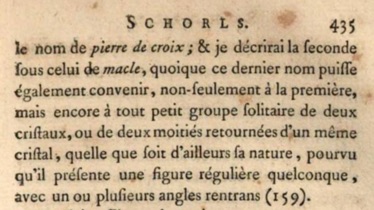The minerals AND CONCEPTS of the Haüy collection
Haüy's personal collection includes a number of minerals from ancient outcrops, some of which will be described later. And, first of all, minerals from France:
Various French mineral from the Haüy collection (from top to bottom, and from left to right) : two azurites from Chessy (Rhône), one ‟staurotide” (twinned cyclic staurolite, Coray-Scaër, Finistère), a ‟feldspath déciduodécimal” (twinned sanidine from Puy du Four Laboue, Puy-de-Dôme) ; and a ‟urane oxydée” (meta-autunite from L’Ouche Diau, Sâone-et-Loire), a ‟chaux sulfatée géminée” (arrowhead-twinned gypsum, Montmartre, Paris) and a native antimony (Les Chalanches, Isère). Scale bar is 1 cm. Paris, MNHN, Haüy collections. Photos: F. Farges.
But also specimens from « older » if not famous historical outcrops :
Various minerals from outside France of the Haüy collection (top to bottom, left to right) : ‟fer calcareo-siliceux” (renamed ilvaite in 1811, Italy), acmite (renamed aegyrine, Norway), « cuivre sélénié argental » in its flask (eukairite, cotype-specimen given by Berzelius who discovered selenium in that sample ; Skrikerum, Sweden) then ‟argent noir” (polybasite, Freiberg, Germany), ‟4e espèce de cuivre arséniaté” under a glass bell (clinoclase from Truro, England, cotype-specimen, given by Count de Bournon), ‟feldspath vitreux verdâtre coloré par du chlorite” (adularia and clinochlore, Saint-Gothard, Switzerland) then ‟cobalt gris” (cobaltite, Tunaberg, Sweden), stellar diamond (most likely Brazil) and ‟urane oxidé” (torbernite, Devonshire, England). Scale bar is 1 cm. Paris, MNHN, Haüy collection. Photos: F. Farges.
from lefty to right : pyrargyrite (‟argent antimonié sufluré prismatique disjoint”, unknown origins) ; two proustites (‟argent antimonié [sic !] sulfuré sexocto décimal”, unknown origins and ‟argent antimonié [sic !] sulfuré de forme indéterminable” from the Himmelsfurt mine, Southern Freiberg, Germany) in which arsenic will eventually be detected instead of antimony. Scale bar is 1 cm. Paris, MNHN, Haüy collection. Photos: F. Farges.
A remarquable specimen, inscribed ‟4390 Sproo-glasertz rapporté par Humbolt de la mine de Fatatecas, au Mexique”. This is a stephanite from Zacatecas given to Haüy by German naturalist and explorer Alexander von Humboldt (1769-1859). Paris, MNHN, Haüy collection. Photo: F. Farges.
‟Quartz hyalin comprimé plagièdre” (exact locality not given, probably from the Mont-Blanc area in France) given by the Swiss naturalist ‟Saussure son” (Nicolas-Théodore, 1767-1845). Scale bar is 1 cm. Paris, MNHN, Haüy collection. Photo: F. Farges.


His working collection is made up of numerous donations: Pierre-Jacques Chiappero (MNHN) counted more than 300 different donors, from the most anonymous such as "Mr. Charpentier" to the "celebrities" of the time such as Alexander von Humboldt.
The autunite show above was given by Joseph François Denis de Champeaux (1775-1845), who discovered this mineral in 1799, later described by Haüy which was renamed « autunite » by British mineralogists Henry-James Brooke and William Hallowes Miller (1852). This sample s the official cotype officiel of this species as the original autunites from Champeaux (his holotypes) seems today to be lost.
Alexander
von Humboldt
Nicolas-Théodore de Saussure
Haûy also coined the concept of pseudomorphosis and epigeny:
Calcite-sandstone (Fontainebleau, France)
Malachite after cuprite (Chessy, Rhöne, France)
Scale bar is 1 cm.
Paris, MNHN, Haüy collection. Photo: F. Farges.



or, from « new » outcrops in the Americas :

« Disthène » (kyanite) (nearby New York, USA) and diamond (Brazil).
Paris, MNHN, collection Haüy. Photos: F. Farges.
It was Romé de L'Isle who introduced first the word "macle" in the sense French-speakers currently know of it i.e., crystal twinning in English, that is the pairing of two or more crystals following specific orientations guided by the laws of crystallography.
But from an initially wise observation (as he is the first to describe twinned crystals), Romé introduces confusion between the original "macle", the chiastolite habit of andalusite that forms crystals with losange sections, with crystal twinning just because he thinks chiastolite and twinned staurolite are two varieties of the same mineral he named "schorl cruciform" (cruciform schorl):
Twinning, hemitropia and geminated
Forging major concepts
On the other hand, Haüy also introduced a new category of crystal pairing: "cristaux géminés" (geminated crystals) which are also pairings without being, for him, hemitropies.
For instance "spearhead" gypsum is named by Haüy "chaux sulfatée géminée" [geminated sulfated lime]:
for Haüy, this crystal habit is not twinned!
Twinned (“spearhead“) gypsum from Montmartre (Paris, France). Specimen of this quality and origin are unfoundable nowadays. Length: 11 cm. Paris, MNHN, Haüy collection. Photo: F. Farges.
Haûy also coined the concept of pseudomorphosis and epigeny which is remarkable at a time when crystallography is still in its infancy: it must face fierce opponents, such as Georges-Louis Leclerc de Buffon (1707-1788), who find in these crystals, perfect examples demonstrating that crystals do not follow the so-called rules of crystallographers (« crystals adapt to any forms, it is not a valid scientific descriptor »). For, indeed, how a sandstone cannot form crystals as a malachite can be cubic? Haüy provided the right answers to Buffon!
Haüy always established a scrupulous difference between the collection of the Museum and his own: the most beautiful pieces, as it was said then, such as those obtained via Weiss or the Austrian emperor, were reserved for the institution of the Jardin des plantes. Nevertheless, he kept the inferior specimens for his working collection
This collection of more than 7,000 specimens - also including rocks, minerals, gems and art objects - must have had an original catalog kept by Haüy but it has disappeared. We have a version translated into French from the Duke of Buckingham's catalog in English (later than Haüy) and updated by the latter.

Naitve silver and calcite (Kongsberg, Norway). Paris, MNHN, Haüy collection. Photo: F. Farges.
Chalcopyrite and fluorite (England). Paris, MNHN, Haüy collection. Photo: F. Farges.

As Lacroix (1944) points out in his condescending way when speaking of Haüy: « il est peu probable qu’il ai donné un coup de marteau au delà de l’Ile de France et de la Picardie » (it is unlikely that he gave a hammer blow beyond the Ile de France and Picardy).
To me, Lacroix surely gave more hammer blows outside Paris (over French provinces and colonial territories...) and inventoried many redundant minerals with his nasty handwriting (so hard to read nowadays) just "to make numbers" than he described new minerals which were not going to be quickly discredited afterwards, for lack of good science... His book on Haüy bears many mistakes and preconceived notions (my opinion)


Haüy reserved the most beautiful minerals from all over the world for the MNHN but kept the duplicates in his personal collection, which few know.
One feels here as much the brilliant intuitions as the errors of the first mineralogists at a time when chemical analysis was going to develop to help clarify these questions.
Nevertheless, French scientists speakers still keep today this language mistakes/abuses.
This history of this confusion is a bit complex :
Christophe-Paul Gautron de Robien (Nouvelles idées sur la formation des fossiles, 1751) mentions that certain cruciform minerals were named "pierres de macles" in Brittany by analogy with the hieraldic macles ("mascle" in old French) that we find, for example, in the coat of arms of the Rohan family (these minerals are today known as the chiastolite variety of andalusite).

Two « croisettes de Bretagne » from he Haüy collection, aka twinned staurolite “obliquangle“ with two individuals known as “Saint-Andrew“ (left) and a cyclic with three individuals (right).
For crystal twinning, Haüy forged the word "hémitropie" (hemitropia): he is right but will not be followed by the French.
After reading Gautron de Robien, Romé de L’Isle convinced himself that the "pierre de macle" (the chiastolite variety of andalusite) is a second basaltic variety (!) of a mineral species he named "schorl cruciforme" (cruciform schorl) or "pierre de croix" (cross stone). The first variety being the "croisette de Bretagne" (which was to be named staurolite from 1792, thanks to Delaméthérie).
Still, Haüy is well aware of these confusions.
He logically keeps "macle" as a mineralogical name, synonym of today’s chiastolite (he does not realize, tough, that chiastolite is a variety of andalusite he named confusingly "feldspath apyre" (meaning fire-proof felspar) that Delaméthérie will be first to rename in 1798 andalousite - and NOT andalusite).
For crystal twinning, Haüy uses instead "hémitropie" (hemitropia).
Pierre Lélu : portrait of Romé de l’Isle
Paris, MNHN, Bibliothèque centrale
...& I will describe the second under that of macle, although this last name can also be appropriate, not only to the first, but also to any small solitary group of two crystals, or of two turned over halves of the same crystal, whatever its nature, provided that it presents any regular figure, with one or more reentrant angles...


The real “macle“ like the one used in French hieraldry for English “mascles“: here, the coat of arms of the Rohan family (Brittany) showing 7 mascles that are not chiastolites and even less what French call “macles“ (i.e., twinning) (French language can sometimes be so confusing !).
A “Pierre de macles“ (chiastolite crystals in a shale) from Les Salles-de-Rohan in Brittany (polished section)
Christophe-Paul Gautron de Robien (1698-1756)
In addition, Romé de L’Isle also convinced himself, erroneously, that chiastolites are twinned crystals. Then, the signification of "macle" in French shifted from a Breton chiastolite to any crystal pairing with reentrant angles and then to any kind of twinned crystals.
In doing so, Romé introduces several confusions between mascle, chiastolite, staurolite and macle.
Curiously, "maclé" (twinned) is said "geminato" in Italian while the historical (or hieraldic) "mascle" is "losanga vuota".
As shown on the right, Gautron de Robien groups "pierres de macles" with another type of Breton "cross stones" locally named "croisettes de Bretagne" (cross-stones from Brittany, today known as twinned staurolites from the Coray-Scäer area).


